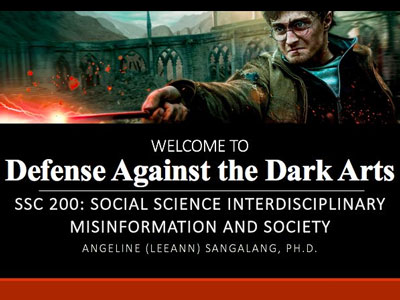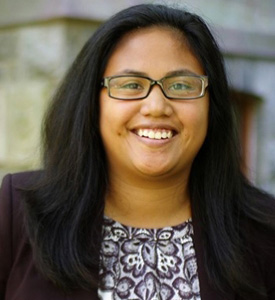Harry Potter and defense against disinformation
Harry Potter had a magic wand to defend against the dark arts. Professor Angeline Sangalang equips her students with lessons in how to ward off misinformation and malfeasance in her interdisciplinary social sciences course that incorporates the much-loved wizard.
The wizarding world of Harry Potter has been brought to UD by a social sciences professor in her class on misinformation and media literacy.

Defense Against the Dark Arts, the title of a course taught by communication assistant professor Angeline Sangalang, ties together themes from Harry Potter and the real-world media landscape. For students, it fulfills their requirement to take an interdisciplinary social sciences course as part of the Common Academic Program. It is one of many topics from which they can choose.
In the Harry Potter book series, wizardry students learn to protect themselves against dark magic. Sangalang believes that our world has dark magic, too, but it appears in the form of disinformation in the news. Being informed is crucial to making sound decisions in the realm of politics, and false information is used against people to manipulate choices, she said.

“Defense Against the Dark Arts highlights the importance of using power, or in this case magic, ethically and minimizing others’ use of power for nefarious purposes by understanding these dark arts and skills to defeat them,” she said.
Sangalang first taught the class fall semester and offered it again this spring. She said she felt it was important to teach these themes to students during both an election year and a global pandemic.
Natalie Blue, a sophomore communication student, took Sangalang’s course in the fall. Blue said she was especially grateful to take this class because of the amount of disinformation around COVID-19 and the election.
“I never knew how impactful misinformation is and how it is all around us,” she said. “I learned a lot about how easily it can spread, how it affects people, and how hard it can be to decipher from accurate and real information.”
“I learned a lot about ... how hard it can be to decipher from accurate and real information.”
Sangalang said she used the insights of her inaugural class to adapt the class’s content for the spring semester, with the advantage of being able to reflect on how misinformation played into the 2020 election.
By choosing an eye-catching class name, Sangalang hopes students will be attracted to learn about media literacy through their interest in popular culture. She said she wants to use Harry Potter as a key to unlock challenging conversations around politics and media.
“I hope some light-hearted analogy through pop culture makes it more invitational, which creates an openness to be challenged and be critical,” Sangalang said.